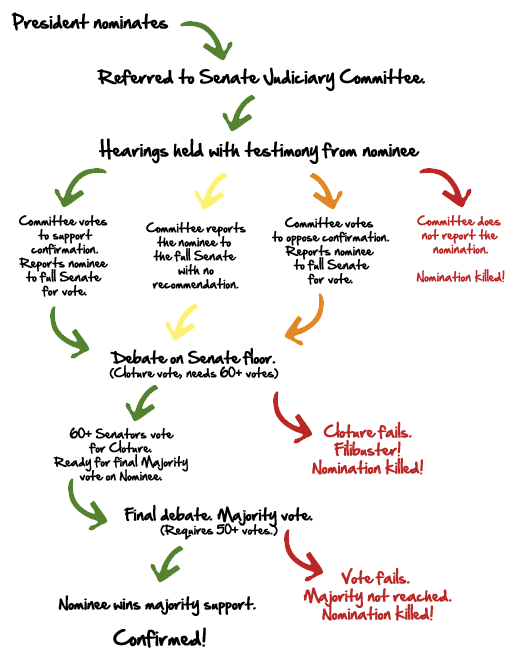What you need to know about Supreme Court nominations
Today’s nomination of Sonia Sotomayor to the Supreme Court will set off the usual partisan bromides about judicial activists, up or down votes, and filibusters. Missing in the exclamatory punctuations of the paid political muppets on television is a background on judicial nominations to help you understand the process. What do you need to know about the process? I’ll try to answer that below.
The key player that you need to follow is the Senate Judiciary Committee. Once the President nominates someone to a federal court — in this case, Sotomayor — they must go through a confirmation process that begins in the Judiciary Committee. The committee consists of 12 Democrats and 7 Republicans, making a successful confirmation hearing highly likely.
The Judiciary Committee has not always been the central player in judicial nominations that it is is now. In the early- to mid-19th century, the role of committees, and even their permanence, was ill-defined. The Judiciary Committee only received one out of three judicial nominations; the rest were approved solely by the full Senate. In 1868, as the committee structure became more normalized and entrenched, the committee began to receive nearly all Supreme Court nominees.
 Despite the move to involve the committee in most every Supreme Court nomination, the committee did not receive testimony from a nominee until 1925. That year, Harlan Stone, then Attorney General, was invited to give testimony about the prosecution of the Teapot Dome scandal and questions raised by a senator opposed to his nomination about Stone’s connections to J.P. Morgan. Testimony was still not a regular, or required, path for a nominee to take before the committee until 1955 when President Eisenhower nominated John Harlan to the Court. Every nominee since John Harlan has faced the questions of the committee in live testimony.
Despite the move to involve the committee in most every Supreme Court nomination, the committee did not receive testimony from a nominee until 1925. That year, Harlan Stone, then Attorney General, was invited to give testimony about the prosecution of the Teapot Dome scandal and questions raised by a senator opposed to his nomination about Stone’s connections to J.P. Morgan. Testimony was still not a regular, or required, path for a nominee to take before the committee until 1955 when President Eisenhower nominated John Harlan to the Court. Every nominee since John Harlan has faced the questions of the committee in live testimony.
The current committee members include Chair Pat Leahy and current Ranking Member Jeff Sessions. In many ways, they represent the partisan and increasingly regional divide within the nation and between the two major parties. Leahy is a liberal New Englander, hailing from Vermont; the Alabaman Sessions is a conservative Southerner. The rest of the committee also shows a regional divide between the parties with the Democrats dominated by senators elected from states in the North East/Mid-Atlantic (5 members) and the Great Lakes/Mid-West (4 members), as the Republicans are largely dominated by Southerners (4 members). Only one committee member, Iowa Republican Sen. Chuck Grassley, comes from a state that his party’s 2008 presidential nominee did not win (Barack Obama defeated John McCain by 9% in Iowa).
While there is little doubt that Sotomayor will make it out of the Judiciary Committee, the process requires a vote of support or opposition for her confirmation by the full Senate. Instead of terminating a nomination in the committee through a vote, the committee instead votes their support and then reports the nomination to the floor for a full vote. There are three options for the committee, report the nominee with a favorable recommendation, report with an unfavorable recommendation, or report with no recommendation. The committee could also refuse to report a nomination, however this has usually only occurred after a nominee has withdrawn from consideration.
In the full Senate, a nominee must overcome a cloture vote prior to a final vote. Cloture, which has largely become a stand-in for filibustering, requires a 60 vote, or three-fifths, majority. This means that a minority of 41 senators could block a judicial nomination. Achieving this number would be unlikely given Democrats hold a 59-40 partisan edge (with the 100th senator waiting to be decided by the Minnesota Supreme Court). After a successfull cloture vote, the nominee would then face a final, simple majority vote.
While this is the ordinary route for a Supreme Court nominee to take, sometimes a nomination gets derailed before the engine gets going. Some nominees simply withdraw after poiltically embarrassing details emerge, as in the case of Douglas Ginsberg after it was revealed that he smoked marijuana with his law school students. Other nominees, like Harriet Miers, withdraw due to political pressure (in Miers’ case, pressure from within her own party).
For an even more detailed look at the history and process involved in the selection and confirmation of a Supreme Court justice (or what my friend and colleague Tim Ball calls 1/27th of the government), check out these two excellent Congressional Research Service (CRS) reports and this Open Congress Wiki page on Senate nominations:

